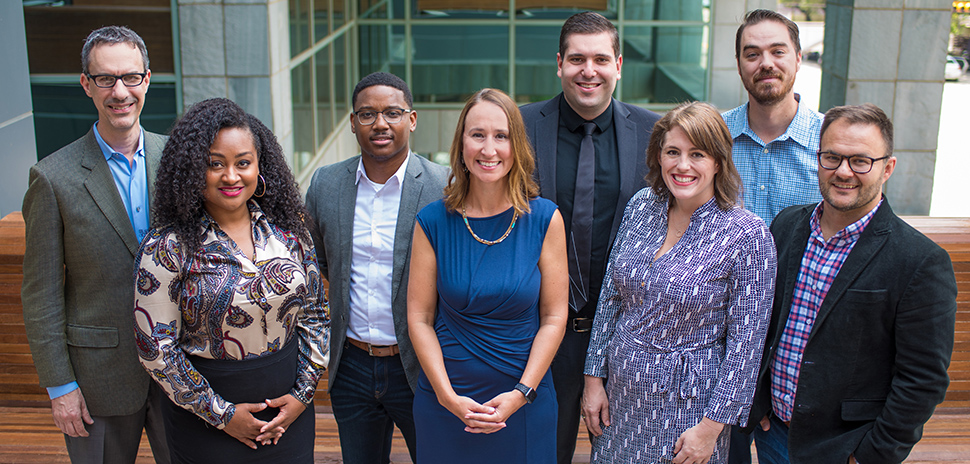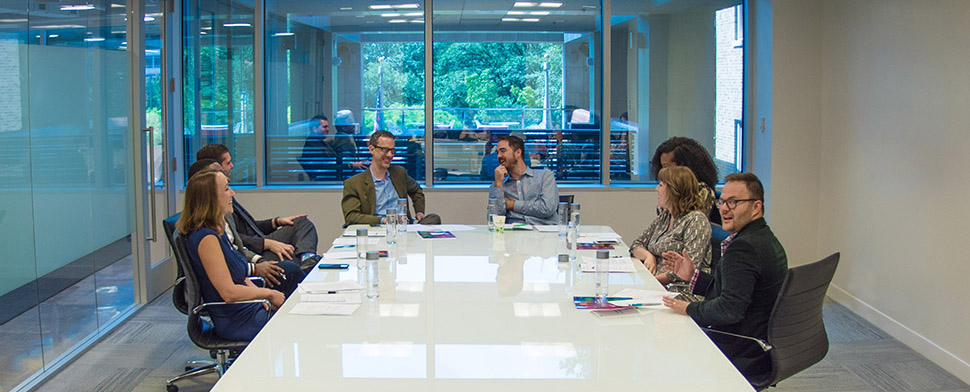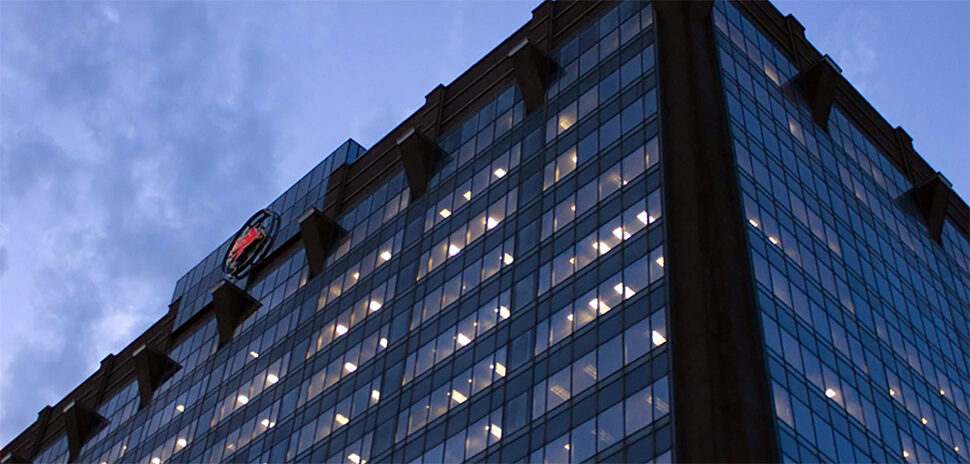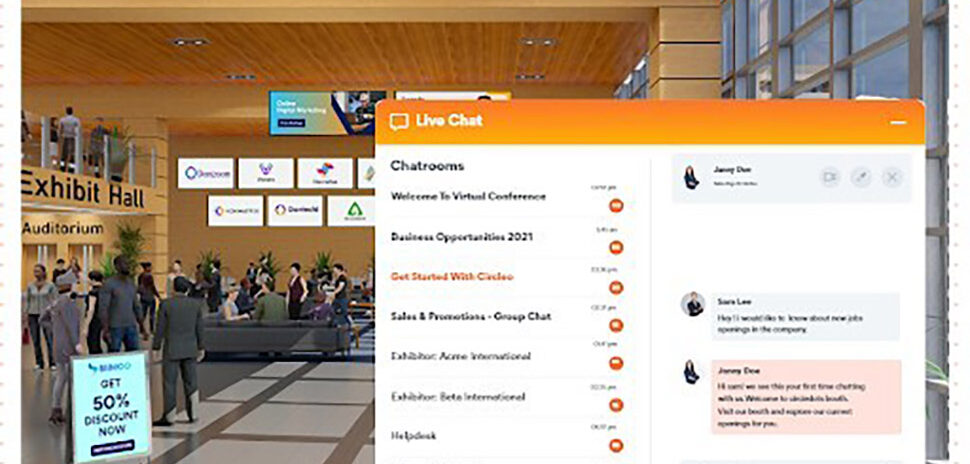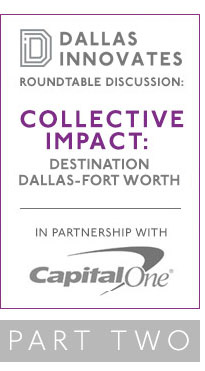 The Dallas Innovates “Collective Impact” roundtable brings together a variety of perspectives — from nonprofits to corporations to startups — to discuss the state of social innovation in the North Texas region and beyond.
The Dallas Innovates “Collective Impact” roundtable brings together a variety of perspectives — from nonprofits to corporations to startups — to discuss the state of social innovation in the North Texas region and beyond.
Our expert panel explores the concept of collective impact in social innovation, talks about the attraction of Dallas as a hub for impact, and asks how we can do more, better. The panel, moderated by Salah Boukadoum, ends with predictions of where things are heading. Boukadoum, as both a social entrepreneur and founder, is uniquely positioned to lead the discussion, as well as participate.
You were introduced to our panel and given a scope for their different perspectives in Part One.
In Part Two, our experts discuss how Dallas-Fort Worth may be a unique breeding ground for social good, what attracts talent for the sector, how collective efforts can make a difference, and more.
Meet the Experts
M O D E R A T O R
 SALAH BOUKADOUM
SALAH BOUKADOUM
Founder, Impact City Initiative; Co-founder, Good Returns Network; CEO, Soap Hope
Boukadoum is a social entrepreneur creating a wide scope of change across the Dallas-Fort Worth region. Boukadoum has created and leads numerous companies across North Texas, including social ventures, nonprofits, and impact organizations. His commentary piece, Dallas: The Impact City, published on Dallas Innovates in our inaugural year, is our most-read Voices article — ever. “My passion is social and economic innovation to empower all 7.5 billion of us,” Boukadoum says.
T H E P A N E L
 KATE KNIGHT
KATE KNIGHT
Director of Innovation, GroundFloor Project, United Way of Metropolitan Dallas
In Knight’s role, she oversees the GroundFloor program, United Way’s social innovation accelerator program that looks for solutions to social problems in the community around occupation, ability, and health. It provides support in terms of funding, mentoring, access to resources, and connections, to make that impact better, faster, and stronger. “I’m pleased to be sitting at this table with a couple of our fellows,” she says. “It’s good company.”
 MATT MYERS
MATT MYERS
Founder E-Capital Summit; Vice President, EarthX
EarthX is known as the ‘largest environmental experience’ as an international nonprofit showcasing the latest initiatives, discoveries, research, innovations, policies, and corporate practices reshaping the future. Myers is also the co-founder and executive director of the EarthX E-Capital summit (in Dallas, April 25-28, 2019), which he calls “a tech investment summit focused on families and foundations.”
 MICHAEL THOMAS
MICHAEL THOMAS
Executive Director, My Possibilities
My Possibilities is a higher education and continued learning program for adults who have special needs. It also provides job placement, job support, and various services for individuals interested in entering the workforce. “Fun fact: Before the nonprofit, there was a thought that I wanted to be a classical pianist,” Thomas says. “I realized there were dudes like him [motioning to Moderator Salah Boukadoum, a former international concert pianist] who were out there, and that was a terrible career path.”
 BENJAMIN VANN
BENJAMIN VANN
Founder and CEO, Impact House
Impact House is a nonprofit business incubator and venture accelerator that connects, supports, and grows diverse entrepreneurs addressing industry inequities and disparities. Not only does it address the racial wage gap, but also provides the underrepresented access to coaching, curriculum, capital, and culture. “We ‘accelerate the best’ in all shades of genius,” Vann says.
 SARA VASSAR
SARA VASSAR
Senior Director, Digital Product Management, Capital One
Vassar is from the Capital One Garage, the company’s innovation lab in Dallas-Fort Worth. Her team is responsible for “building out the innovation muscle” at Capital One’s Plano office. “The team facilitates bringing products to market,” Vassar says, “and we are helping to do that better, faster, and cheaper.”
 STEVE WANTA
STEVE WANTA
Co-founder and CEO, Just
Just invests in low-income female entrepreneurs by providing capital and small loans, alongside coaching, to create more visibility in the community. “Our higher purpose is to create a more just world,” Wanta says, “Less stress, and more joy.” Just is based in Austin, but Wanta says because of United Way GroundFloor, they’ve chosen Dallas as the next destination to expand as part of a long-term vision to change the narrative.
 MICHELLE WILLIAMS
MICHELLE WILLIAMS
Executive Director, Southern Region, The Dallas Entrepreneur Center
A nonprofit organization driving innovation and economic impact, the Dallas Entrepreneur Center (DEC) is dedicated to helping entrepreneurs start, build, and grow their businesses. “I’m overseeing the launch of three locations in Oak Cliff, specifically one at Red Bird Mall, which I’m so excited about,” she says. True to her collaborative spirit, she adds, “There’s also Paul Quinn College and UNT Dallas to encourage entrepreneurship in higher education.”
Driving Dallas
SALAH BOUKADOUM: Matt , you’ve spent a lot of time around the world, so you have a sense of the global perspective in Dallas, and Kate, you’re deeply ingrained in what is going on in the heart of the city. From your unique vantage points, what is the special nature of Dallas that makes it a great place for social innovation — or that could make it a great place for social innovation?

Matt Myers
MATT MYERS: There are a few variables. I’d say number one is money, because there’s a high concentration of philanthropic capital in DFW. How to best tap that has not been figured out. There’s a lot of learning that needs to take place, and there are many other variables: Cost of living is more reasonable, and there are a lot of corporations here, etc. But, what we really need is for that philanthropic capital to help fund entrepreneurs at an early stage of development. Do we risk it a bit? The better that we as an ecosystem can the solutions for doing that — and make them feel comfortable—the better off DFW is going to be.
KATE KNIGHT: It’s not a unique problem for social innovation. United Way partnered with the Dallas Regional Chamber, SMU, and Accenture on an innovation study and discovered that. overall, startups in Dallas felt there was a lack of an appetite for risk among early-stage investors. They felt we needed a higher risk tolerance. At United Way, in our corner of social innovation, we’ve seen a growth in that. We’ve seen people start to “get it” a little more. There’s undoubtedly a “wealth of wealth” here in North Texas.
“There is undoubtedly a “wealth of wealth” here in North Texas. As we grow our concept of social innovation — and people understand it more — there’s more ability to take a risk.”
KATE KNIGHT
As we grow our concept of social innovation — and people understand it more — there’s more ability to take a risk. The other thing, and I will look at my friend Steve [Wanta] because he pointed this out to me: There’s definitely a community of corporations here where people are willing to talk to you. They’ll tell you who to talk to next and ask how they can help. And there’s definitely a network of people here that want to see this kind of work grow and succeed. Steve, I’d love for you to weigh in as someone who in the last year has come to Dallas and experienced this.
STEVE WANTA: Well, I feel like I’m a little bit of a spy from Austin. There’s a faction in Austin that says we’re going to be the capital of social innovation: I think the mayor actually made a proclamation at one point.
KNIGHT: And, so did Salah [referring to Dallas as The Impact City].
Editor’s Note: Moderator Salah Boukadoum’s commentary piece, Dallas: The Impact City, is the most-read “Voices” column on Dallas Innovates to date.
WANTA: Salah and I have talked a lot about what the ingredients are for that. Philanthropy and capital, in general, are important. We all have an opportunity to continue to evolve our thinking. There need to be more models around for which we develop new systems. There’s a tremendous amount of inequity when it comes to access to opportunity, and we have a couple of people at the table who are doing that kind of work. But, we have a long way to go. No one has figured it out.
In Dallas, I’ve been impressed with how willing people are to open a door and say “yes.” And that doesn’t necessarily have to be about money. I’ve been able to have a lot of great conversations quickly. Much of that has to do with people at this table: Salah and Kate. The organizations that you represent have given us a needed “seal of approval.”
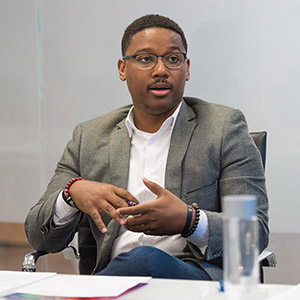
Benjamin Vann
“In Dallas, I’ve been impressed with how willing people are to open a door and say ‘yes.'”
STEVE WANTA
BEN VANN: You guys are definitely right. But I’ll give a different perspective. Being in philanthropy and working as a fundraiser, I see the value of corporations and being in a city in the United States. At the same time, I think there’s an opportunity for Dallas and DFW to democratize philanthropy. Steve [Wanta], when you talk about the access of being able to meet with United Way and others — there are a lot of people that don’t have that. There isn’t a community that those people can go to and ask, “Where do I go? Where do I start? Where are people that look like me?” Right?
There’s an opportunity when it comes to capital, because that’s literally what most entrepreneurs need. We talked about corporations and the impact of investing. What the middle ground is really saying, is that impact investing is investing in diversity. An article in Forbes stated that if you invested in diversity it could contribute almost $3 million dollars to the economy.
When we think about investing in Dallas, everyone knows we’re an oil and gas, and a real estate city. And wehn you think of impact investing in affordable housing, we did. But, actually investing in people of color, and women, and LGBTQ members, and people that don’t have access — that’s impact investing because you’re going to get your market returned. If you make a solid investment, you’ll be able to move the equity gap in terms of access, who is getting opportunities, and who is getting to have sit-downs with the “who’s who” of the city. So, I agree, but I think we need to ask, “How we can unlock philanthropy? How can we get the philanthropic community to say, we’re going to unlock our capital and invest in all shades — not just the ones we’re accustomed to seeing?”
“I think we need to ask, “How we can unlock philanthropy? How can we get the philanthropic community to say we’re going to unlock our capital and invest in all shades — not just the ones we’re accustomed to seeing?”
BENJAMIN VANN
SARA VASSAR: I agree that there’s a desire for the people in Dallas to give back more. In 2017, our DFW associates volunteered 48,671 hours, and, since January, our local associates spent more than 21,235 hours in volunteer service. So we know there’s a need. And they’re not all the Gen Y people, referred to earlier. I believe that Dallas has an ability to get things done. I think there’s a need for this upscaling of drive investment and funding — so that Dallas is growing exponentially.
We know that there’s a tremendous need to develop our future workforce with skills for the 21st century. Corporations need those skills. The entrepreneurs who are starting their businesses are going to need those skills. Capital One did a study with Burning Glass in 2017 on the digital skills employers demand from workers, and how to close the digital skills gap. The study shows more than 8 in 10 (82%) of middle-skill jobs will require digital skills in the future. We did another study with IFTF that revealed the North Texas region will experience some of the fastest growth in middle-skill jobs. So just the need itself and how fast we are growing will drive this city to not having any choice.
BOUKADOUM: Michelle, what’s special about Dallas, or what’s needed in Dallas?
MICHELLE WILLIAMS: Dallas is an extremely passionate city. It’s full of very passionate community members. Even our transplants come in and drink the Dallas “spirit juice” very quickly. It’s because we have that passion and a desire to see the community do it right that we’re able to have this kind of collaboration. And, we have grit. In Dallas, we’re going to do it ourselves, and we’re going to figure it out.
There are many great examples, such as Impact House and the Heritage Giving Fund, which is a fund that specifically funds innovation centered around black women. There’s an equity, and no one is waiting for the powers that be to figure it out. We’re coming together as a community, and we’re going to just do it. That’s what makes Dallas so special when it comes to social innovation. When you tie passion to collaboration to grit — that determination to just get it done — you see amazing and beautiful things happen. That’s why the region is such a great place to be for social innovation.
“Dallas is an extremely passionate city. It’s full of very passionate community members. Even our transplants come in and drink the Dallas “spirit juice” very quickly. It’s because we have that passion and a desire to see the community do it right that we’re able to have this kind of collaboration. And, we have grit.”
MICHELLE WILLIAMS
MICHAEL THOMAS: A strange—and new—perspective for me is, if you look at giving in general, typically in the top 50 cities, it’s Dallas, it’s San Antonio, it’s Austin, it’s Houston. Texas gives quite a bit. I just spent a week in California meeting with organizations that do what we do here in Texas, but out there. Those organizations are in a state that has incredible funding. I realized something: And not to be political, but when a state is incredibly well-funded, certain social services are less creative. … I met with organizations [in California] that couldn’t figure out how to do what we are doing on four times our funding. And I realized that there’s a structure of Texas, to this day, that’s very poorly funded in almost every social sector. We’re forced to be creative: We have to leverage partnerships with the corporate world and the philanthropic world. We have to be creative or else these different groups of people are just never supported.
The Nonprofit Scope
BOUKADOUM: Not everyone on the panel has a nonprofit lens, but everybody has relationships and/or partnership opportunities with nonprofits. Kate, what is the key that drives success for nonprofits that are really focused on social innovation?
KNIGHT: People start nonprofits on passion. Then they get far enough down the road to where they can’t stop, but have to figure out everything else. Because if they don’t, then they can’t. There’s no way they can keep going. Reflecting on what it takes for a nonprofit to really stick, I think there are three things in the long term.
One is the board. Not just having the right people on the board, but the people who know what their job is as a board member. There’s a huge gap in our community right now on board training. And it’s not just the board members, but also how an executive director works with the board, and how that comes together.
Two is investing in the staff. This is true for every startup, but easily more than half of the organizations we see aren’t paying themselves as they get started. That’s normal. But sometimes you have got to pay yourself. You have got to pay your rent. You can’t help people if you’re not stable. And, as you get bigger, it’s not always about the dollars. Once you’re paying your rent, for example, there are benefits that don’t cost a lot that can recruit talent — whether that’s flexible working schedules or a ‘baby at work’ program. There are many creative things you can do to invest in your people.
The third thing that you can’t get away from: People have to know about you, and they have to trust you. If you’re going to stick around for the long haul, you have to have a brand that people know about. That means getting the word out — the publicity of who you are and what you can be — you’re trustworthy.
Those are the three most important things to establish in order to be there for the long haul.
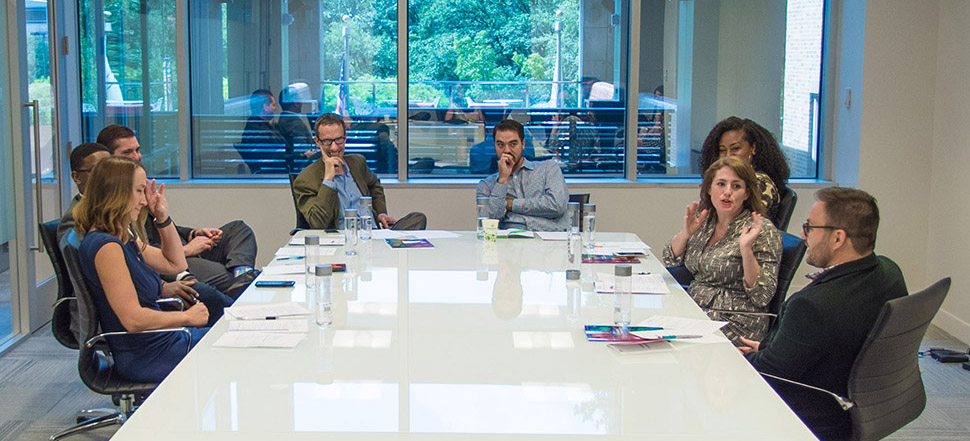
BOUKADOUM: Michelle, you have a different lens. You see a whole lot of nonprofits, some of them care about sustainability in business models, some of them not as much.
WILLIAMS: With the most successful organizations, in contrast to some of the ones that could use a little help, I see a parallel to what Kate was saying. I think it’s understanding how important your team is. New startups often want their friends and their colleagues and their mama on the board. Sometimes it works, but when you’re looking at getting funded, one of the first questions a good grant agency is going to ask is, “What does your team look like?” and “Why is this the best team to execute whatever thing it is you’re trying to execute?” Thinking through what your team looks like is a key thing that new nonprofits and startups miss.
The other thing is just taking advantage of collaboration. For example, we pride ourselves on the community aspect, and try to make sure that we have numerous events to bring people together. That creates an opportunity for people to talk and brainstorm and collaborate. Because Dallas — and Texas — is a friendlier place to do business, we can really take advantage of that. And have a little bit of humility: Ask the question, “I don’t know what I’m doing here, who can I talk to?” “Can somebody help me in this area?”
KNIGHT: And: “Who else is doing what I’m doing in this area?”
WILLIAMS: Yes. If there’s somebody already doing that work, there’s nothing wrong with saying, “Hey, can we link arms and do this together?” You’re going to find that funders are more likely to fund collaborative works as opposed to a one-off.
BOUKADOUM: Ben, I want ask you what may be a controversial question around the collaboration piece. There’s a movement — not just in Dallas, but everywhere — to say we have too many nonprofits. Should we be merging them or should we be combining them? Is that true?
VANN: I’ll follow up with what Michelle was saying and add my piece on where I think nonprofits are struggling. One area is defining impact. A lot of times, nonprofits go in with a passion, but they don’t know the business side. They don’t know what they’re actually trying to solve. If you know what issue you’re trying to solve — or the venture you’re trying to move — it helps you develop the things that channel up to those outcomes.
KNIGHT: That goes back to what you said earlier about design thinking and how we challenge our fellows: Are you in the community? Do you know what you know?
“A lot of times, nonprofits go in with a passion, but they don’t know the business side. They don’t know what they’re actually trying to solve. If you know what issue you are trying to solve — or what venture you’re trying to move — it helps you develop everything that channels up to those outcomes.”
BENJAMIN VANN
VANN: So defining impact is important because that affects the dollars that you get from the foundations and how they look at who you are serving, how many people you have served, what areas you are serving. They’re like, I didn’t think about that.
BOUKADOUM: Some people say we’ve got too many nonprofits. Others say we need to drive more differentiation and innovation. There are really strong feelings on both sides.
VANN: I believe it’s true. 83 percent of North Texas nonprofits are less than $100,000 budget is a stat that I’ve used.
BOUKADOUM: Michael, you have direct experience of what it’s like to bring organizations together. Will you share some of that with us?
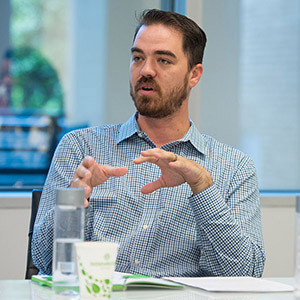
Michael Thomas
THOMAS: We started that process back in May of last year. Our chairman and another board chairman got together to talk and said, “Look, things are happening — we’re kind of in the same space. We’re starting to overlap a little bit more than we used to — is this of value?” We were recipients of the Better Together Fund and went from, should we collaborate, to just upfront. Both boards identified this as a merger opportunity: “Let’s put two organizations together and leverage the value that we both bring to the table.” And in every single way, shape, and form, the merger has paid dividends in the first five months.
We merged in February and placed more people in the community than in all of 2017, with the same staff. The courses are better, and the relationships are better. What we did really, really well — but not very effectively — was in the job placement world. They did great in the job placement world, but they didn’t know how to educate. They weren’t building relationships with corporations. We brought all this together and put it under one house. I can’t keep up with what they are doing right now.
There are ten other organizations — no offense to any of them — that are kind of in the space game. We’re sitting back, like “Game of Thrones.” We’re looking around, trying to figure out where we’re going. There are amazing opportunities to improve similar services in other places.
I love being totally transparent, but the boards are the biggest hurdle. And ego is the biggest hurdle of all. But the truth of the matter is, when you’re rooted in mission and heart — and working from that place of “we’re doing this to make a difference in the world,” it’s almost impossible to let that go because it’s too much about your personal investment.
“When you’re rooted in mission and heart and you are working from that place of ‘we’re doing this to make a difference in the world,’ it’s almost impossible to let that go because it’s too much about your personal investment.”
MICHAEL THOMAS
VANN: The point I’d like to make is on the sustainability part. If philanthropy is moving towards that early stage, that’s really in capacity building as they are moving towards stability. That’s where nonprofit and social enterprise-type business models really thrive. The business side is more of a proactive side and the nonprofit side is more of a reactive. We need money so we can do the work versus the proactive.
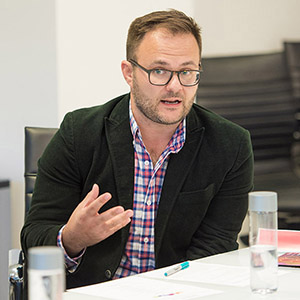
Steve Wanta
WANTA: I think we have a risk of oversimplifying a nuanced conversation. If you say we should stop starting nonprofits, you could also say we should stop starting new businesses. I think the question becomes, “How do we create value, and who pays for it?”
We didn’t know what we were going to do. So [we] ultimately created a competitor to a Nobel Peace Prize winner. Many of the clients from the Nobel Peace Prize winner have left and joined us. … Plenty of companies see opportunities to take over another company. Whole Foods, where I worked for 10 years, is a great example. They were a great culture people, [maybe] not very good grocers. They acquired Bread and Circus in the northeast. And they were amazing grocers. So Whole Foods became a better entity, but if they had never created another company, that never would have happened.
You just articulated why it’s important that multiple nonprofits are created. For us, we made a strategic decision to convert from an unknown entity for-profit, into a nonprofit. We’re dealing with money. People, if we lend money, and we’re a for-profit social enterprise, immediately they will think we are looking to maximize profit.
It’s so important to ask ourselves, “What’s the best way for us in this room to create more impact? And, how do we fund that to serve as many people as possible?”
If you say we should stop starting nonprofits, you could also say we should stop starting new businesses. I think the question becomes, “How do we create value, and who pays for it?”
STEVE WANTA
BOUKADOUM: Matt, should we be specializing, or should we be generalizing, in order to be more effective in this space?
MYERS: That’s a tough question. What’s most interesting about this conversation is that everybody has said what needs to be said. We talked about the board of the directors, we talked about focusing on the impact you’re having and measuring that so you can get more money, and we talked about taking care of your team. Because everybody knows when you work for a nonprofit it’s twice as hard, for half the pay. And, we talked about ego.
I think the thing is — and where this conversation is going — is the difference between a for-profit and a nonprofit. I’m working my way through that because I also see for-profit companies that are having a really positive impact. I’m trying to get money driven towards them, because I find that for-profits can tend to be more efficient than nonprofits. I’m not saying that nonprofits don’t play an important role. It’s just that we need to better define what that role is or who holds those roles. What’s happening in the states that I work in is that more and more we are finding that people can do well by doing good. We’re getting more and more people who are saying, “Hey, I can have a positive impact on the planet and people — it’s community with a business. I might make a little less, but I feel I can sleep a lot better.”
We talked about the board of the directors, we talked about focusing on the impact you’re having and measuring that so you can get more money, and we talked about taking care of your team. Because everybody knows when you work for a nonprofit it’s twice as hard, for half the pay. And, we talked about ego.
MATT MYERS
KNIGHT: What you’re saying has been my personal mantra for many years. It’s really a continuum, where there are the charities on one end and the capitalists on the other. … The innovation is in the middle. Where we exist here is in the middle. Corporations can do good and do well. Then it’s the nonprofit versus a charity. A nonprofit is a tax filing. It’s a perception thing. In the middle, in the gray: That’s where the magic happens. That’s where the impact is.
THOMAS: We’ve tried unsuccessfully to shift the identification of our organization away from nonprofit because there’s a fallacy rooted in the difference between for-profit and nonprofit. At the end of the day, a for-profit company and nonprofit company should operate exactly in the same way, in my opinion. The difference is, at the end of the year, the for-profit company has net revenue and it uses its net revenue to pay shareholders, stockholders — all that great stuff. We can shift away from terms like ‘nonprofit’ and move to something called for-cause. For-profit and for-cause organizations function exactly the same way. But at the end of the year, the for-cause organization would still have the net profit rather than having to pay back to stockholders.
KNIGHT: They give their bonuses out.
THOMAS: Absolutely. I’m pro-overhead, and I’m pro investing in talent and investing in people. But that money, instead of going to stock, it goes back to the cause. It goes back to the impact. Can we scale up the people we are helping? We’re so rooted in this: You can’t invest in people, you can’t pay bonuses, you can’t have overhead. We, literally, are just driving this wedge between the two. Now, we’ve seen a push toward social innovation and benefit corporations. All this stuff is starting to play in the middle to respond to that problem.
WANTA: So just to be a bit contrarian: Businesses are intended to be capital efficient and use money as a resource to make more of it. I agree with you that there’s a perception of nonprofit as inefficient, as charity. Yet … they need to raise charitable dollars to solve a social problem, and there’s nothing wrong with that. At the core of what you’re saying is that we should all be really efficient.
THOMAS: We should all invest in the same expenses.
WANTA: I don’t agree we should invest in the same expenses. If I’m [a corporation] I’m going to make a massive capital investment because that money is going to return 10X the money. And if we don’t have enough nonprofit space, it’s a clear way to measure the social return. And that is our great challenge. What’s beautiful about business is a black and white look at the bottom line, nuanced even with that — but it is, in fact, different.
BOUKADOUM: Sara, what do you look for in partners in our communities, and what makes certain ones stand out for you?
VASSAR: Thank you for coming back to that. I’ve never run a nonprofit, but I do have experience with partnering with nonprofits. I agree that with strong mission-driven nonprofits, it’s easy to build confidence and trust in your partnerships. So that’s number one. You want to align with a partner that’s aligned with you and is going to reach the same goals that you want to reach. But the other thing I’ve noticed, especially at Capital One, is the partners that are great for us are really partners. It’s not, “Hey, we’re coming to Capital One to get resources we need.” We’re also having a dialogue about how we can learn from them. It’s thinking about the partners as partners, as customers.
“You want to align with a partner that’s aligned with you and is going to reach the same goals that you want to reach. But the other thing I’ve noticed, especially at Capital One, is the partners that are great for us are really partners.”
SARA VASSAR
We have a supplier diversity program called Catapult with our nonprofit partner WBENC. It’s very similar to what we do in Dallas with the DEC, where we helped mentor a number of women small business owners. I’m amazed at what we learned from them: The courage they have. The things they have to deal with. And I don’t have a way to measure what our entrepreneurs learned from them in Capital One, but it’s amazing. So just knowing that we have that collaboration with the nonprofits we work with sustains our relationship going forward. Maybe that resonates with you.
This roundtable has been edited for brevity and clarity.
TOMORROW
PART THREE
Are there areas of social innovation that we are neglecting in the Dallas-Fort Worth region that we should be paying more attention to? What needs to be done to create more impactful change for the future? Part three of our Collective Impact roundtable series will publish on Oct. 24 on Dallas Innovates. The conversation turns to the future, and our experts share what they’re most passionate about.
READ NEXT
COLLECTIVE IMPACT: DESTINATION DALLAS-FORT WORTH
A PANEL OF EXPERTS ON SOCIAL INNOVATION IN THE REGION
PART ONE
Collective Impact: Social Innovation in Dallas-Fort Worth
What makes Dallas-Fort Worth a destination for global impact work? Part One kicks off with eight thought leaders who explore what social innovation looks like from their unique perspectives — nonprofit, corporate, and startup — and how that is impacting the region.
PART TWO
Collective Impact: Making Dallas-Fort Worth a Hub for Social Innovation
What makes North Texas a place—or a potential place—for social innovation? In part two of our roundtable series, our experts discuss how Dallas-Fort Worth may be a unique breeding ground for social good, what attracts talent for the sector, and more.
PART THREE
Collective Impact: ‘Tomorrow belongs to those who can hear it coming.’
Our panel talks about what we can do better, right now. In the final installment of the latest Dallas Innovates roundtable series, we look at systemic issues that still need to be addressed, and the areas ripe for innovation. The discussion closes with a look into the future.
Dallas Innovates, Every Day: Sign up for the enewsletter.
